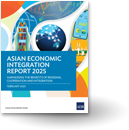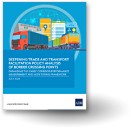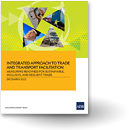Spotlight Archives
- ADB Working Paper Series on Regional Economic Integration No. 50 - Regional Surveillance for East Asia: How Can It Be Designed to Complement Global Surveillance?May 2010Shinji Takagi suggests that a regional surveillance mechanism for East Asia must cover the operational requirements of the Chiang Mai Initiative Multilateralization (CMIM), and also respond to the region’s evolving need for a formal framework of policy dialogue and cooperation as economic integration deepens and macroeconomic interdependence strengthens. Read more.
- Asian Development Outlook 2010: Macroeconomic Management Beyond the Crisis13 April 2010ADB's annual flagship publication, the Asian Development Outlook 2010, sees developing Asia emerging from the recent crisis and posting a strong recovery in the next two years, as a moderate global recovery supports a modest revival in global trade. Investment is expected to remain strong and private consumption is anticipated to improve. Inflation will pick up, but at manageable levels. Beyond the crisis, developing Asia faces the challenge of adjusting its monetary, exchange rate, and fiscal policies to foster macroeconomic stability and sustained growth within the broader direction of a return to prudence and discipline. The report provides a comprehensive analysis of economic performance for the past year and offers forecasts for the next two years for the 45 Asian economies that make up developing Asia. Read the report, highlights, and news release.
- ADB Working Paper Series on Regional Economic Integration No. 45 - The 2008 Financial Crisis and Potential Output in Asia: Impact and Policy ImplicationsApril 2010In this paper, Cyn-Young Park, Ruperto Majuca, and Josef Yap investigate the post-crisis behavior of potential output in emerging East Asian economies by employing the Markov-switching model to account for structural breaks. Results show that after the 1997/98 Asian financial crisis, potential output in Hong Kong, China; the Republic of Korea (Korea); Singapore; and Malaysia reverted to levels consistent with trends prior to the crisis. Econometric estimates of a simple growth model show that the differences among the patterns of post-crisis recovery can be attributed to the investment-to-gross-domestic product (GDP) ratio; macroeconomic policies; exchange rate behavior; and productivity. These results can be used to guide policy in the aftermath of the 2008 global financial crisis. Read more.
- ADB Working Paper Series on Regional Economic Integration No. 46 - Do Hub-and-Spoke Free Trade Agreements Increase Trade? A Panel Data AnalysisApril 2010A panel data consisting of 96 countries and covering the period 1960–2000 was used by Joseph D. Alba, Jung Hur and Donghyun Park to investigate the effects of free trade agreements (FTAs) and hub-and-spoke systems of FTAs on exports. Their empirical results indicate that in addition to the direct trade liberalizing effect of FTAs, the hub-and-spoke nature of FTAs has an additional positive effect on trade. Read more.
- ADB Working Paper Series on Regional Economic Integration No. 48 - Crises in Asia: Recovery and Policy Responses April 2010This paper by Kiseok Hong and Hsiao Chink Tang find that recovery from a recession in Asian economies is somewhat slower than in OECD economies, but recovery from a financial downturn is not much different. In addition, OECD economies have been more active and effective in implementing counter-cyclical measures than Asian economies but Asian economies may have better success in the current global crisis. Read more.
- ADB Working Paper Series on Regional Economic Integration No. 47 - Does a Leapfrogging Growth Strategy Raise Growth Rate? Some International Evidence April 2010Zhi Wang, Shang-Jin Wei, and Anna Wong test the leapfrogging strategy— the use of government policies to promote high-tech and high-domestic-value-added industries beyond an economy’s natural development—on 165 countries and 259 cities in the People’s Republic of China. They find no evidence that the strategy contributes to higher growth. Read more.
- Hong Kong, China and New Zealand sign Closer Economic Partnership Agreement29 March 2010Hong Kong and New Zealand signed on 29 March 2010 the Hong Kong, China - New Zealand Closer Economic Partnership Agreement (CEP Agreement). This is Hong Kong's first free trade agreement with a foreign economy. The CEP Agreement will implement liberalisation measures on both trade in goods and services. It will also facilitate investment flows and movement of business persons between the two economies. The CEP Agreement is expected to come into force in the last quarter of 2010. Read the official press release of Hong Kong, China and New Zealand. Follow New Zealand-Hong Kong CEP Agreement on ARIC's website (resources include legal documents, studies and research, news, and more).
- Asia Bond MonitorMarch 2010The latest quarterly edition shows the value of Asia's local currency bond markets expanded 16.5% to $4.4 trillion in 2009, with the corporate bond market expanding much faster than the government market. The main driver of regional growth was the rapid expansion in markets in Hong Kong, China; Thailand; and Indonesia. Further market expansion is expected this year as economic recovery continues and companies see the local currency bond market as an alternative funding source. Read full report. See news release.
- ADB Working Paper Series on Regional Economic Integration No. 43: A Macroprudential Framework for Monitoring and Examining Financial SoundnessMarch 2010Lotte Schou-Zibell, Jose Ramon Albert and Lei Lei Song describe concepts and tools behind macroprudential monitoring, and the growing importance of macroprudential tools for assessing the stability of financial systems. Using data from selected developing economies in Asia, South America, and Europe, as well as selected economies from the developed world, they also estimate panel regressions to quantify the impacts of the major influences on key financial soundness indicators, including capital adequacy, asset quality, and earnings and profitability. Read more.
- ADB President Haruhiko Kuroda speaks at Global Reserve System Conference and Foreign Correspondents' Club, Tokyo17 March 2010President Kuroda on Wednesday delivered the keynote speech before a distinguished panel of economists at the "Future Global Reserve System - an Asian Perspective", jointly organized by OREI, ADBI, and Columbia University's Earth Institute. The President later gave a luncheon briefing to international media on "Economic Prospects and Challenges for Developing Asia" at the Foreign Correspondents' Club of Japan.




